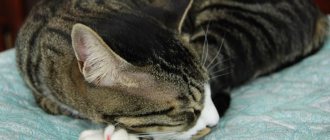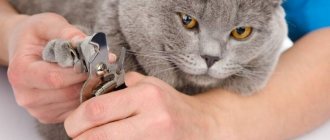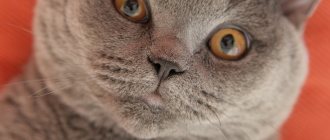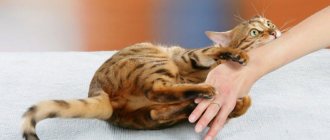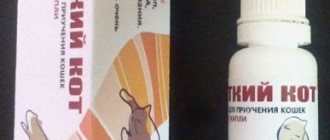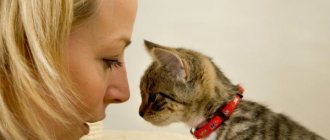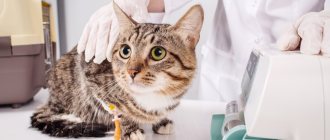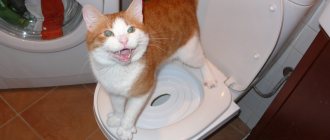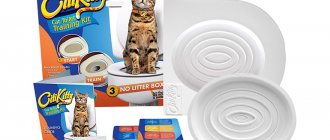Hardware manicure and pedicure are gaining more and more popularity every year. If at the beginning this method of nail treatment was treated with caution, today it has almost completely replaced trimming from beauty salons. This is due to the purity of the final result, the complete safety of the procedure and the speed of its implementation. Such processing is carried out using special equipment, the consumables of which are abrasive pedicure caps (which replace a nail file).
Abrasive caps
What are silicone claw pads (anti-scratch)
Anti-scratch pads are cap-shaped covers for animal claws. The caps are made of soft, flexible silicone. The linings are also called “soft claws”. They are placed over cats' clipped claws to protect them from scratching.
anti-scratch is a device for protection against scratching
Anti-scratch pads were invented by veterinarian Toby Wexler (USA). This discovery became an alternative to onychectomy (declaw removal), as painful removal was considered the most inhumane way to protect against scratching. In civilized countries, onychectomy is prohibited, so anti-scratch treatments quickly became popular throughout the world. They come in different sizes, so they are suitable for cats aged four months and older. In addition, caps are now sold in different colors. However, anti-scratch pads are not just a fashionable device; sometimes purchasing such pads is vital. It is recommended to purchase claw pads in the following cases:
- if the animal is aggressive and rushes at guests;
- if the cat is overly playful and therefore violently attacks family members;
- if the cat is jealous and cannot come to terms with the appearance of another pet in the house (trying to “revenge” it);
- if there are small children in the house;
- if your pet has health problems (for example, with atopic dermatitis, the cat itches, scratching the skin until it bleeds).
Veterinarian advice
Here's what experts say about it:
- Apply protection only to healthy animals. If there are infectious and fungal lesions on the paws, this should not be done.
- Make sure that dirt and pathogenic microorganisms do not accumulate between the finger pad and the cap, otherwise this will threaten your cat with serious health problems.
- Glue the anti-scratch pads carefully and efficiently so that excess glue does not inadvertently stick together the animal’s fingers. This can lead not only to discomfort, but to the development of inflammation and allergies.
- Judging by the reviews, silicone caps for cat claws can cause irritation, allergies and swelling. If you notice such symptoms, immediately contact your veterinarian, who will painlessly remove the pads and prescribe appropriate treatment.
The benefits and harms of anti-scratch products for cats
anti-scratch products can be harmful to your pet's health
The benefits of anti-scratch pads are obvious. A cat wearing such a “manicure” will not be able to harm either things or children. Moreover, the animal will not be able to harm itself.
Every cat breeder has seen how cats itch. Some animals do this with particular frenzy. In this case, the pet can scratch its skin until it bleeds (or even tear its skin). Because of this, wounds are formed, which itch even more as they heal. They can also become infected.
In addition, some “advanced” cat owners try to purchase all kinds of devices for their pets. Instead of gray (yellowish, sometimes ugly) claws, the cat's paws will have beautiful "soft claws." But in addition to benefits, anti-scratch products can also cause harm. The pad may grow into the pad of the paw. But claws can grow in without a cap, so this is only indirect harm. You need to examine your pet's paw more often. Typically, ingrowths occur when they are not applied correctly. According to the rules, the cap should not fit to the claw all the way to the base, but with an indentation of several millimeters. You should also not put caps on untrimmed claws.
In addition, the cat can get injured (and even pull out a claw) if the pad gets stuck in something. To prevent this from happening, you need to monitor what the animal comes into contact with. For example, the cap can get stuck in grilles or cracks, or get caught in blinds or long carpet fibers. After all, a cat walking outside can get stuck in a tree or get caught on a nail. Control is especially important at first, until the cat adapts to the anti-scratch treatment.
Reviews from veterinarians about anti-scratch products for cats
In addition to ordinary cat lovers, it is worth asking the opinion of veterinarians on the issue of cats wearing rubber caps. The opinion of experts is not so rosy, since in any case, for cats, the procedure of gluing the pads is equal to stress.
A cat under natural conditions can grind its claws down if necessary, but a kitty with a bright manicure is forcibly deprived of this instinctive ability. This is also stressful for the animal. You should not think that the purr is adapting - most likely, this is not adaptation, but humility.
Veterinarians do not recommend anti-scratch kits for cats that have the opportunity to walk - in case of danger, she will not be able to defend herself and climb a tree.
How to choose anti-scratch products for cats of different ages
Anti-scratch pads can be used from 4 months of age
Depending on the age of the animal, you need to choose the size of the pads. To do this, you need to have an idea of the system of their sizes:
- tiny (XS) - for kittens from 4 months;
- small (S) - for cats whose weight is 2.5–4 kg;
- medium (M) - for cats from 4 to 7 kg;
- large (L) - for large breeds of cats (from 8 kg and above).
If the issue with the size of the pads is resolved, you need to pay attention to other nuances. As a rule, the caps are packaged in a transparent bag (the bag may be inside the box). Review the product. The linings must be smooth, without flaws or damage. The packaging must be undamaged. Pay attention to the instructions and labels on the packaging. The manufacturer should not cause you any doubts.
When faced with a choice between an expensive, high-quality item and its budget option, the latter often wins. However, anti-scratch products are not an expensive purchase in themselves. The packaging lasts a long time, which means you can buy the more expensive option.
Rules for using anti-scratch pads
Before you start working with anti-scratch products, you need to carefully study the instructions
The package can include up to 40 pads, glue and instructions. Before starting work, you should carefully study the operating instructions. If you stick the caps only on the front legs, the package will be enough for 4 times. The pads stay on the claws for up to 8 weeks. If the cat does not take them off earlier, and you put them on strictly according to the instructions, then the packaging will last for several months (up to six months) . If you make a mistake with the size, the caps can be changed at the seller or trimmed. At the time of fitting it will become clear whether there is such a need.
When not to cap cats' claws
Anti-scratch guards are intended for domestic cats. That is, for those animals that do not end up on the street. Firstly, the owner cannot always keep track of the cat if it goes out. And there are many dangers on the street (for example, claw injury). Secondly, the animal must be able to climb to some height (if necessary).
Anti-scratch guards should also not be placed on the claws of pets prone to allergies (the cat may not tolerate glue). The original packaging comes with good quality glue, so the risk of allergies is low. But no one can guarantee the quality of the glue that comes with cheap fakes.
It is not advisable to stick caps on the claws of a sick cat
If your pet is sick, it is better not to irritate him with innovations. A weakened animal may not resist, but due to an unexpected “manicure” the cat may become stressed. This may make the condition worse.
How to glue cat claw caps
Before gluing the pads, you need to organize a fitting (without glue) on already trimmed nails. There is no need to trim the nails completely. It is enough to cut off the sharp corner of the claw and also treat it with a nail file on all sides. After this, the claws are degreased, for example, with alcohol (you can use acetone, but the cat may not like the pungent smell). This is necessary for better adhesion to the glue. The cap should not slip off, and its edges should be at a distance of 3–5 millimeters from the base of the claw. If this indentation is not a balloon, then the overlay can be shortened using scissors. After trying on all the caps, you can begin gluing. You need to work with glue very carefully. If there is too much of it, a drop of glue will fall on the cat's fingers, and it will hurt the cat when it moves. You can follow the following plan:
- Calm the cat (you can pet it or give it a treat) so that it is not afraid.
- Place a small amount of glue inside the cap.
- Take the cap in your right hand, and lightly press on the paw with your left so that the animal releases its claws.
- Place the cap on the desired claw (without releasing your left hand).
- Make sure that the glue does not get on the skin near the claw.
- Wait a while (5 minutes) until the glue dries.
If there is still a lot of glue, you need to wipe off the excess with a napkin. This must be done quickly so that the glue does not have time to dry. After gluing all the caps, the cat will try to rip them off, so you need to distract the cat (with food or a toy) for some time after the procedure.
Terms of use
Before directly performing a pedicure using a router, you need to acquire several attachments, as well as rubber holders that match them in shape and diameter. These bases are reusable. They are purchased once and when processing leather they are only equipped with an additional coating (thanks to a rubber attachment). The caps used for pedicure are attached to the cutter before the actual treatment of the skin/nails.
During a hardware pedicure, it is necessary to use several grinding caps of varying hardness. To treat artificial nails, you should choose coatings with a grain size of 60-80 grit. These same attachments can also be used for the initial removal of dead skin.
Pedicure with abrasive caps
Secondary sanding of the leather should be carried out using medium grit caps (150 Grit). The final stage of the pedicure is the final treatment of the dermis with 320 Grit attachments, making the skin smooth, soft and velvety.
Important: A new set of sand caps must be used for each client. Reuse of such tools is impossible, because Skin particles remain on them and bacterial growth accelerates. Reuse is possible only if you perform a home pedicure using diamond tips (they don’t wear out so quickly).
Individual set of caps for pedicure
Sanding caps are an indispensable assistant in performing high-quality pedicures. Disposable attachments allow you to make the skin soft and tender, and the nail plate as smooth as possible. At the same time, they do not pose a threat to the client’s health (provided that the specialist follows safety measures).
How often should you change cat claw attachments?
It is possible that from time to time the cat will remove the anti-scratch protection itself.
If your four-legged friend sometimes tears off (loses) the pads, they can be re-glued. You cannot use the old cap; you will need to glue a new cover each time. Moreover, you don’t have to wait until all the anti-scratch pads fall off; you can add them one at a time.
Some who have never tried it before buy several sets of anti-scratch products in different colors. For example, in bags of 10 or 20 pieces. Using the entire set at one time, for “correction” you will have to open another bag. The next time you completely replace all the pads, one cap may not be enough. Therefore, it is more convenient to buy anti-scratch pads with a large number of pads of the same color, for example, 40 or 60 pieces. Or buy several packages of different colors and mix. Such methods are suitable for those people who already have an adult cat (the size of the claw will not change).
Of course, anti-scratch pads do not stick forever. The natural claw must sometimes be released, but tearing off a tightly fitting pad is painful for the animal. Therefore, you can wait until your pet's claw is updated. As the claw tissue is renewed, old cells will die off. Thus, the cap will easily come off along with the dead layer of the claw. This can happen about a month after gluing. In younger cats, this period may be shorter (about 3 weeks), but this is rare. A properly glued cap can last up to 8 weeks.
Reviews from owners and veterinarians
Sometimes cat owners devote so much time and effort to caring for their pet that it becomes difficult not to share their experience with others
There are many online forums devoted to topics about cats and cats. Cat breeders share their victories and disappointments, experiences and knowledge. And sometimes inexperienced pet owners just need advice. Few owners know about anti-scratches. Those who have already tried to use them are either satisfied with the device (and praise it) or disappointed (and criticize it). Some people who tried anti-scratch products got completely unexpected results.
I glued these to my cat, they are great. What’s funny is that I haven’t even run out of one box, but I stopped gluing them to him, I just continue to cut them, because he’s used to his nails not being scratched and has stopped even tearing up rugs. But I glued them to him from a young age. When you glue, make sure that the glue with the cap does not stick to the finger, otherwise the nail will grow and it will hurt the cat.
Forum user
https://m.woman.ru/home/animal/thread/4363561/https://m.woman.ru/home/animal/thread/4363561/
It often happens that after improper use unpleasant consequences occur. And the point here is not in the shape of the caps, or even in the quality of the glue. It’s just that every new item always evokes many different emotions. And here it’s up to you to decide whether to use it or not.
These anti-scratches are not needed, I was convinced from my own experience. I bought them for my cat, now I am suffering both myself and the cat. She took off all these caps, I didn’t re-sculpt them so as not to torture the animal, but one of her caps couldn’t be removed, and the nail festered. Today I wanted to take her to the vet, but Sunday is a day off, and in the evening I’m going on a business trip until Friday, how will my cat be here without me.
tory11, forum visitor
https://www.zoovet.ru/forum/?items=20&page=2&tem=307273&tid=18
Caps for Pedicure. Comparative review of German and Chinese
Hello! My name is Nabok Irina. Today we’ll talk about pedicure caps, or rather we will compare the prices and qualities of German and Chinese caps.
60 grit
I have cheap caps, and I also have Lukas caps. I think everyone knows that this is a German company, it is used by almost every master who knows the technology of hardware or combined pedicure. Let's compare them in performance and price . The first stage in a pedicure is the removal of the underlying keratosis. For this I use 60 grit caps . On the right side there is a green lukas, and on the left there is a Chinese cap at a very modest price.
Let's look at the quality of the spraying. In these two caps it is uniform. Lukas have a small peculiarity: when they work, they leave very large scratches, sometimes deep. Even the next cap is quite difficult to sand. But with caps from the Alpha-Neil company such questions do not arise: these caps evenly remove the layer without leaving deep scratches.
Many may doubt the quality of the Chinese cap, thinking that they may be bald and do not remove enough keratoses. But this is not true, it showed itself to be excellent at work and does not crumble. No worse than its German counterpart))
80 grit
The next most abrasive caps are 80 grit . They are used for less keratotic feet. I have two of them in the cheaper version. On the right side is lukas.
Let's compare the substrate on the left side. The fabric backing is the same as the lukas cap, but you can clearly see that it is thicker. Although this does not affect the work in any way. We'll talk about how they are inserted a little later. In the middle there is a cap on a plastic base - it does not bend, in principle, just like on a fabric base in the same price category.
The abrasiveness of German and Chinese caps is absolutely the same. The coating is uniform without any protruding grains.
150, 120, 180 grit The following are 150, 120, 180 grit. They work approximately the same and are used for final grinding. We have three caps. The ones on the right are lukas, and the two on the left are cheaper Chinese options. In terms of spraying, they are the same: everything is excellent and even. Believe me, there is no difference in work either.
40 grit There is also a category of heavyweights - this is 40 grit . I have never seen anything like this at Lukas. But they are represented in the Alfa-Neil company.
Diameter 13mm - 150, 180 grit There is also a category of 13mm caps with abrasiveness 150,180 grit. On the left side the lukas are green. Used as final polishing. In terms of coating, the two caps are worthy of each other.
Diameter 5mm - 325 grit
Now let’s compare the smallest cups in diameter and abrasiveness - 325 grit, diameter 5 mm . On the left side is lukas. As for me, lukas even loses, because there are some nicks and irregularities on it.
Basics
Let's compare the 2 basics. On the right side is Chinese, the other is German. Chinese caps fit in and even come out perfectly. The German one also fits well, but a little tighter, because it itself seems to be a little rubberized.
Little Nailhack from Irina Nabok)) If your base has shrunk and no longer holds the cap as before, the cap slips - take a lint-free napkin, cut off a small piece and push it into the recesses of the base. Thus expanding it. This can not be done in all cavities, but only until the cap is well fixed.
My conclusion on the caps is that without even thinking about it, take caps from the cheaper segment, only from this particular company!! I can’t recommend others yet, since I haven’t tried them. They were 100% suitable for my work. Although I consider myself a fairly sophisticated craftsman who has worked on German caps and worked on them for quite a long time, nevertheless, my choice is cheaper caps. I didn’t find any serious differences between German and Chinese ones, and the price is almost twice as different.
Now I understand masters who do not want to learn hardware pedicure)) After all, in order to provide a client with disposable caps, you need to spend a lot of money, plus all other consumables. But after this review, I hope that many masters will become interested in hardware pedicure and stop being afraid of unreasonably inflated prices, will happily improve their qualifications in my aesthetic hardware pedicure course, and will provide clients with high-quality and useful services!
Irina Nabok was with you. Easy and comfortable work for you, masters!
Hardware Pedicure Intensive https://vip.grandnail.com/apparatniy-pedicure-intensiv
HARDWARE PEDICURE - ONLINE ADVANCED PROFESSIONAL COURSE
Links to caps from Alpha Nail from the video review “Caps for Pedicure. Comparative review «:
06320 Cap for polishing nails 6mm fine https://bit.ly/2wOMzKk 13040 Cap 13mm super coarse 40grit (large hyperkeratosis, corns) https://bit.ly/2WF4rXk 10060 Cap for pedicure 10mm super coarse https://bit.ly/ 2F8FMzE 10060 Pedicure cap 10mm super rough https://bit.ly/2WywJ0D 13060 Pedicure cap 13mm super rough https://bit.ly/2ICYsZ5 10080 Pedicure cap 10mm rough https://bit.ly/2Wv2o36 10080 Cap 10mm rough 80grit plastic https://bit.ly/2WC3xWp 10080 Cap for pedicure 10mm rough https://bit.ly/31v8FPR 13080 Cap for pedicure 13mm rough https://bit.ly/2MIEQrJ 13080 Cap 13mm rough 80grit plastic https:/ /bit.ly/2RanpPw 10120 Cap 10mm medium 120grit plastic https://bit.ly/31t7512 10120 Cap 10mm medium 120grit elastic https://bit.ly/2KfR1KL 10150 Cap for pedicure 10mm medium https://bit.ly/ 2WCCDCN 10180 Cap 10mm small 180grit plastic https://bit.ly/2X6GuaL 13120 Cap 13mm medium 120grit plastic https://bit.ly/2ZkfHFm 13150 Cap for pedicure 13mm medium https://bit.ly/31s4dSc 13180 Cap 13mm small 180 grit plastic https://bit.ly/31tMNnV 13180 Cap 13mm medium 180 grit https://bit.ly/2Rbbpx
0101.013 Pedicure cap 5mm small https://bit.ly/317RuDc 0101.001 Rubber base 5mm https://bit.ly/2YcoGMG
Read also:
» FILES AND BASES FOR MANICURE. COMPARATIVE REVIEW
» REVIEW OF PACKAGE FROM ALPHA-NEIL
» Review of ExpertNail manicure hood
» AN ORDER HAS ARRIVED FROM TNL
» Nail files. How to choose. Which one for what
Rate the article and ask if you have any questions
comments powered by HyperComments
Tags
caps for pedicure hardware pedicure Chinese German compare Lukas Lukas Alpha nail
